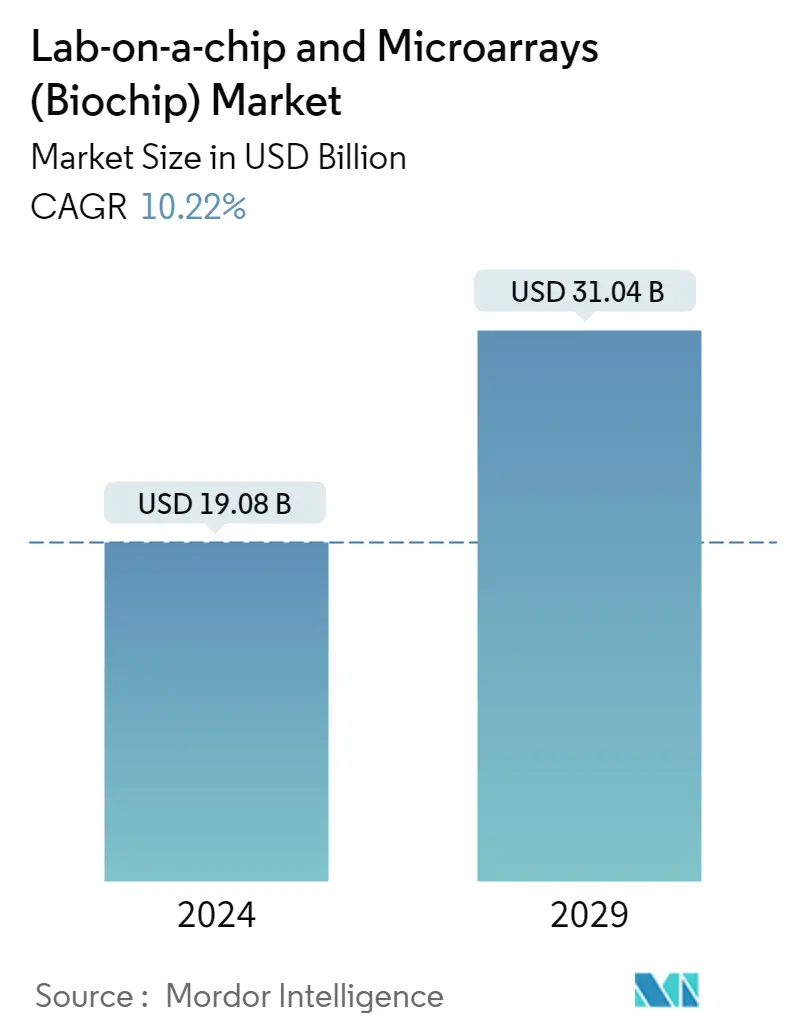Market Size of Lab-on-a-chip and Microarrays (Biochip) Industry

| Study Period | 2021 - 2029 |
| Market Size (2024) | USD 19.08 Billion |
| Market Size (2029) | USD 31.04 Billion |
| CAGR (2024 - 2029) | 10.22 % |
| Fastest Growing Market | Asia Pacific |
| Largest Market | North America |
Major Players
*Disclaimer: Major Players sorted in no particular order |
Lab-on-a-chip and Microarrays Market Analysis
The Lab-on-a-chip and Microarrays Market size is estimated at USD 19.08 billion in 2024, and is expected to reach USD 31.04 billion by 2029, growing at a CAGR of 10.22% during the forecast period (2024-2029).
The COVID-19 pandemic significantly impacted the lab-on-a-chip and microarrays (biochips) market. For instance, an article published by the journal Nature Communication in January 2021 reported that this microarray could be used as a diagnostic tool, as an epidemiologic tool to estimate the disease burden of COVID-19 more accurately, and as a research tool to correlate antibody responses with clinical outcomes. Thus, the COVID-19 pandemic increased the demand for lab-on-a-chip diagnostic tools. However, in the current scenario, it is anticipated that with the presence of other chronic and infectious diseases, the demand for the studied market is expected to increase over the forecast period.
The factors driving the growth of the studied market are increasing demand for point-of-care testing, increasing incidences of chronic diseases, and increasing application of proteomics and genomics in cancer research. Most market players are focusing on the development of new and technologically advanced diagnostic tests. Chronic diseases are the leading cause of death and disability across the world. For instance, an article published by the journal Plos One in March 2022 reported that 21% of the elderly in India had at least one chronic disease. Chronic diseases are the leading causes of disability and mortality among the elderly population in India.
Similarly, another article published by European Public Health Conference in January 2022 reported that more than 3 million people will be affected by cancer by 2030 in Europe. Globally, chronic diseases (CDs) are found to be the leading causes of disability and morbidity. Since those diseases are chronic, accurate and timely clinical decision-making is required. In this direction, research toward developing new lab-on-a-chip-based POC systems for the diagnosis of chronic diseases is an emerging area. Thus, a high incidence of chronic diseases is expected to drive the growth of the studied market.
Biochips are increasingly being used in the field of biomedical and biotechnological research. With the advancement of technologies, there has been a rise in the adoption of biochips in proteomics. The advantages of protein biochips are the low sample consumption due to their inclination toward miniaturization. These characteristics of microarrays are important for proteome-wide analysis. Proteomics is being widely adopted for biomarker and drug discoveries. For instance, in April 2021, PathogenDx Inc. reported that the USFDA had issued an Emergency Use Authorization (EUA) for its patented COVID-19 multiplexed viral diagnostic assay, DetectX-Rv. DetectX-Rv is an RT-PCR and DNA microarray hybridization test intended for the qualitative detection of nucleic acids from SARS-CoV-2 swabs. Thus, such approvals for new products are also contributing to the growth of the studied market.
Thus, due to the increasing demand for point-of-care testing, increasing incidences of chronic diseases, and increasing application of proteomics and genomics in cancer research, the studied market is expected to witness significant growth over the forecast period. However, the design constraints of lab-on-chip technology and the availability of alternative technologies may slow down the growth of the studied market.
Lab-on-a-chip and Microarrays Industry Segmentation
As per the scope of the report, a biochip is a collection of miniaturized test sites (microarrays) arranged on a solid substrate that permits many tests to be performed at the same time to achieve higher throughput and speed. Typically, a biochip's surface area is no larger than a fingernail. Like a computer chip that can perform millions of mathematical operations in one second, a biochip can perform thousands of biological reactions, such as decoding genes, in a few seconds.
The Lab-on-a-chip and Microarrays Market is Segmented by Type (Lab-on-a-chip and Microarray), Products (Instruments, Reagents and Consumables, and Software and Services), Application (Clinical Diagnostics, Drug Discovery, Genomics and Proteomics, and Other Applications), End User (Biotechnology and Pharmaceutical Companies, Hospitals and Diagnostic Centers, and Academic and Research Institutes) and Geography (North America, Europe, Asia-Pacific, Middle-East and Africa, and South America). The market report also covers the estimated market sizes and trends for 17 different countries across major regions globally. The report offers the value (in USD million) for the above segments.
| By Type | |
| Lab-on-a-chip | |
| Microarray |
| By Products | |
| Instruments | |
| Reagents and Consumables | |
| Software and Services |
| By Application | |
| Clinical Diagnostics | |
| Drug Discovery | |
| Genomics and Proteomics | |
| Other Applications |
| By End User | |
| Biotechnology and Pharmaceutical Companies | |
| Hospitals and Diagnostic Centers | |
| Academic and Research Institutes |
| Geography | ||||||||
| ||||||||
| ||||||||
| ||||||||
| ||||||||
|
Lab-on-a-chip and Microarrays (Biochip) Market Size Summary
The biochip market, encompassing lab-on-a-chip and microarrays, is poised for substantial growth over the forecast period, driven by increasing demand for point-of-care testing and the rising incidence of chronic diseases. The COVID-19 pandemic has significantly influenced the market, enhancing the demand for diagnostic tools that can provide rapid and accurate results. This surge in demand is further supported by the growing application of proteomics and genomics in cancer research, as well as the development of technologically advanced diagnostic tests. The market is characterized by the miniaturization of biochips, which offers advantages such as low sample consumption, making them ideal for proteome-wide analysis. These advancements are facilitating the adoption of biochips in biomedical and biotechnological research, particularly in biomarker and drug discovery.
North America is expected to experience significant growth in the biochip market, attributed to the presence of key market players and robust healthcare infrastructure. The region's market expansion is further bolstered by collaborative activities among healthcare giants investing in microarray technology research and development. The high prevalence of chronic diseases in the region, coupled with advancements in microfluidic technology for point-of-care diagnostics, is driving market growth. The competitive landscape of the biochip market is moderately concentrated, with major players like Abbott Laboratories, Agilent Technologies Inc., and Thermo Fisher Scientific Inc. leading the charge. These companies are actively engaged in innovations and collaborations to enhance their product offerings and maintain a competitive edge in the market.
Lab-on-a-chip and Microarrays (Biochip) Market Size - Table of Contents
-
1. MARKET DYNAMICS
-
1.1 Market Overview
-
1.2 Market Drivers
-
1.2.1 Increasing Demand for Point-of-care Testing
-
1.2.2 Increasing Incidences of Chronic Diseases
-
1.2.3 Increasing Application of Proteomics and Genomics in Cancer Research
-
-
1.3 Market Restraints
-
1.3.1 Design Constraints of Lab-on-chip Technology
-
1.3.2 Availability of Alternative Technologies
-
-
1.4 Porter's Five Forces Analysis
-
1.4.1 Threat of New Entrants
-
1.4.2 Bargaining Power of Buyers/Consumers
-
1.4.3 Bargaining Power of Suppliers
-
1.4.4 Threat of Substitute Products
-
1.4.5 Intensity of Competitive Rivalry
-
-
-
2. MARKET SEGMENTATION (Market Size by Value - USD million)
-
2.1 By Type
-
2.1.1 Lab-on-a-chip
-
2.1.2 Microarray
-
-
2.2 By Products
-
2.2.1 Instruments
-
2.2.2 Reagents and Consumables
-
2.2.3 Software and Services
-
-
2.3 By Application
-
2.3.1 Clinical Diagnostics
-
2.3.2 Drug Discovery
-
2.3.3 Genomics and Proteomics
-
2.3.4 Other Applications
-
-
2.4 By End User
-
2.4.1 Biotechnology and Pharmaceutical Companies
-
2.4.2 Hospitals and Diagnostic Centers
-
2.4.3 Academic and Research Institutes
-
-
2.5 Geography
-
2.5.1 North America
-
2.5.1.1 United States
-
2.5.1.2 Canada
-
2.5.1.3 Mexico
-
-
2.5.2 Europe
-
2.5.2.1 Germany
-
2.5.2.2 United Kingdom
-
2.5.2.3 France
-
2.5.2.4 Italy
-
2.5.2.5 Spain
-
2.5.2.6 Rest of Europe
-
-
2.5.3 Asia-Pacific
-
2.5.3.1 China
-
2.5.3.2 Japan
-
2.5.3.3 India
-
2.5.3.4 Australia
-
2.5.3.5 South Korea
-
2.5.3.6 Rest of Asia-Pacific
-
-
2.5.4 Middle-East and Africa
-
2.5.4.1 GCC
-
2.5.4.2 South Africa
-
2.5.4.3 Rest of Middle-East and Africa
-
-
2.5.5 South America
-
2.5.5.1 Brazil
-
2.5.5.2 Argentina
-
2.5.5.3 Rest of South America
-
-
-
Lab-on-a-chip and Microarrays (Biochip) Market Size FAQs
How big is the Lab-on-a-chip and Microarrays (Biochip) Market?
The Lab-on-a-chip and Microarrays (Biochip) Market size is expected to reach USD 19.08 billion in 2024 and grow at a CAGR of 10.22% to reach USD 31.04 billion by 2029.
What is the current Lab-on-a-chip and Microarrays (Biochip) Market size?
In 2024, the Lab-on-a-chip and Microarrays (Biochip) Market size is expected to reach USD 19.08 billion.

